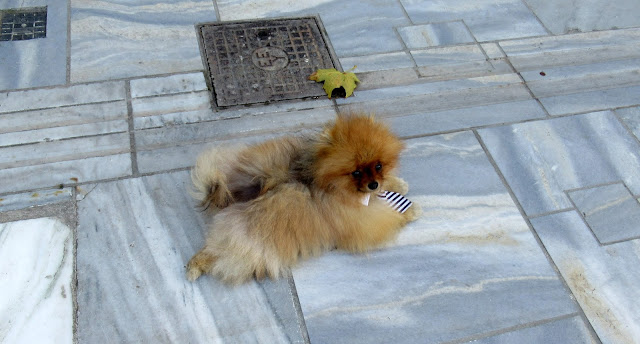Dionyssou Aeropagitou is one of the nicest walks in the city of Athens: it's quiet, pleasant, with excellent views and there's always lots going on.
Back on Dionyssou Aeropopagitou and opposite the steps leading to the theatre, we saw the newly-installed sculpture of Maria Callas.
Lots of places to sit and soak up the sun here
During the rulership of the tyrant of Peisistratos (6th cent. BC) the growth of the city's population necessitated the construction of a well organised system of fresh water to supply the city's needs. An extremely complex water-providing net was opened, subterranean to a great extend, divided into several branches, covering a distance of more than 9,500 metres. The fresh water was led from the Hymettus mountains into the town through sealed clay pipes, laid in underground tunnels. A certain branch of this network has been traced to the east side of the Pnyx hill, and supplied water for more than eight centuries.
The installation consists of a rectangular chamber, chiselled into the bedrock with a shallow well across the entrance where the water is collected. By the time of the emperor Adrian (2nd cent. AD) the floor of this chamber was decorated with an elaborate mosaic.
Yet her paintings don't fetch the kind of prices that those of male artists do.
In a recent article Hall W. Rockefeller argues that despite the fact that Kahlo's face has been emblazoned on everything from t-shirts to tote bags and pencil cases, and despite the fact that she has been the subject of tens of museum shows and books and even a Hollywood, film she is still not considered a 'great' artist. She argues that there have still been no great women artists, and here, she quotes Linda Nochlin, because: 'the fault, lies not in our stars, our hormones, our menstrual cycles... but in our institutions'. In the 21st century, for an institution, read the market: 'greatness, in this new golden age of wealth and vanity collecting, is inextricably linked to money, selling prices and auction results, and in this realm, women fall short of greatness'.
into Eptachalkou Street
The queue outside this shop that sells organic produce was long, people waiting patiently for their turn.
Past this church
The gallery we wanted to visit was still closed
So we walked on,
At 12:00 o'clock we retraced our steps and got to the gallery just as the owner was arriving. The Richard Long exhibition was wonderful.
The sight of the homeless people sleeping under this awning broke my heart. One woman was awake, sitting in the midst of her meagre possessions, so I went up to her and had a chat.
Soon, we had reached Asomaton Square, the main square in Thision.
MOMus gallery is just around the corner. The Cornelius Grammenos exhibition was thought-provoking and fun.
Lots of street sellers as well. You can still pick up a bargain here if you look closely enough: a few years ago, I picked up an Emile Galle bowl for 7 euros.
Finally, we stopped for a delicious lunch at Kuzina.


































































No comments:
Post a Comment